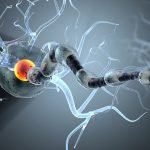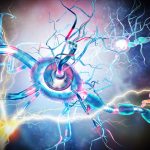A Perfect Storm: Case Study of a 20-Year-Old with a Psychotic Episode
Tolle Causam
Joyce Knieff, ND, EAMP, RH(AGH)
Jennifer Kaltunas, ND, eamp
As healthcare professionals, one of the most prized skills, developed as a result of our profound education and practice, is that of differential diagnosis. While some cases are straightforward, more often than not a patient may present with a complex presentation that warrants a thorough investigation. This is especially the case when dealing with mental/emotional symptoms. The myriad diagnostic criteria and symptom presentations of psychiatric illnesses aside, mental/emotional symptoms are often the canary in the coal mine for issues going on in other bodily systems. Mental/emotional symptoms, as well as cognitive symptoms, are as commonly a result of serious endocrine problems as they are of standalone psychiatric illness, making it especially important that a presenting patient be evaluated with care for several different systems.
The Patient
Take, for instance, one particular 20-year-old male who had just finished his freshman year at college. We’ll call him Adam. He came into the office with his mother as a result of a psychotic episode that started 5 weeks prior. Adam’s symptoms included grandiose ideas, hallucinations, increased energy and confidence, poor appetite, and decreased need for sleep (he would only be able to get 2-4 hours per night). He became quite loquacious with urgent and pressured speech, and he frequently suffered from mood swings – of which irritability and anger were major players.
Adam ended up spending 9 days in a local hospital and then 2 weeks at a local psychiatric hospital. He had since returned to live with his parents and had chosen to go off most of his medications. His symptoms diminished from their original intensity, but he still very much suffered from persistent insomnia, grandiose ideas, loquacity, racing thoughts, and extreme irritability. His mother wanted another professional opinion on his diagnosis, as well as on other possible routes of treatment, especially since Adam refused to see a psychiatrist due to his negative experiences at the psychiatric hospital.
After further intake, it became clear that Adam’s symptoms had been building gradually over the previous 3 months and had intensified during the 5 weeks prior to the point at which medical attention was urgently needed. This episode started in the college fraternity house, which he shared with 5 other men. He described this living situation as “chaotic,” on top of the stresses he was already experiencing in school. Starting 3 months before his office visit, Adam also developed a habit of very heavy and continuous cannabis use as well as moderate alcohol use (both of which he claimed to have stopped using 5 weeks prior). His mother felt that the cannabis aggravated his symptoms; however, Adam disagreed with this sentiment, stating that the cannabis helped him cope with the stress he was experiencing.
Symptoms & Evaluation
At this point in time, it is fair to consider a number of psychiatric diagnoses based on the features of Adam’s psychotic episode. In addition to schizophrenia, schizoaffective disorder, and delusional disorder, bipolar I and II, as well as marijuana-induced psychosis, can be added to the differential. However, as stated previously, it is entirely possible that Adam’s symptoms could be due to a sinister organic cause.
A review of systems found that, in addition to his current symptoms, Adam also had a lingering cough with brown sputum production following a fever and sore throat that began 5 weeks prior. He had trouble taking a deep breath, especially while lying down. He had experienced frequent sore throats within the past year, and currently suffered from both increased daytime sweating and night sweats, extreme thirst and frequent urination, as well as hypertension, tachycardia, cold hands and feet, dizziness, and chest pain when he smoked. His appetite was poor, and he had a host of gastrointestinal symptoms, including nausea, alternating constipation and diarrhea, abdominal pain, gas, indigestion, bad breath, and belching. His medication history, at various points, included a course of amoxicillin at the hospital, lorazepam, olanzapine, haloperidol, quetiapine, and lithium. He recently also began taking levothyroxine and liothyronine, as a result of labs done in the psychiatric hospital.
A number of these symptoms are concerning and possibly indicative of dysfunction in other systems of the body. Given that Adam developed an upper respiratory tract infection around the time his psychotic episode began, a cerebral spinal infection should be ruled out. Causes of immune system dysfunction that might explain the frequent infections and night sweating must also be considered. For example, delirium manifesting as “fluctuating cognitive, perceptual and behavioral disturbances, altered level of consciousness, inattention, sleep-wake cycle disturbance, and delusions” are common in HIV-positive children and young adults,1 especially those exposed to polypharmacy, substance abuse/withdrawal, underlying CNS disease, and thyroid disease. Although cancer is not commonly known to cause serious psychiatric symptoms, some types of hormone or neurotransmitter-producing carcinoid cancers unquestionably have the potential to induce psychosis,2 as well as cause symptoms such as tachycardia, hypertension, dizziness, and others.
The extreme thirst and frequent urination, as well as some of the gastrointestinal symptoms, might indicate serious endocrine dysfunction. For instance, in diabetes, while delirium and psychosis have often been reported in relation to hypoglycemic states, there have been cases where hyperglycemia correlated with psychotic episodes.3 Furthermore, given Adam’s medication history of lithium use, it is not unreasonable to consider nephrogenic diabetes insipidus as a secondary development. Although there is less evidence that nephrogenic diabetes insipidus can cause psychiatric symptoms, it is not unheard of that central diabetes insipidus can present with confusion, psychosis, seizure, and coma.4
Presently, the selection of a working diagnosis becomes extremely difficult without lab work, because while many of these symptoms can manifest due to organic causes, they are also common with extreme psychological agitation. The co-occurrence and chronological development of psychiatric symptoms and organic disease also become difficult to tease apart in a case like Adam’s. While it is entirely possible that an organic disease preceded Adam’s episode, there have also been cases where a new diagnosis of type 2 diabetes followed within days to weeks of a psychotic episode.5,6
Physical Exam & Lab Testing
Adam had a whole host of laboratory testing during his hospital stays, which included positives such as elevated white blood cells (specifically neutrophils, lymphocytes, and monocytes), positive urine cannabinoids, elevated AST, elevated serum ammonia, mild elevation of TSH (with normal T3 and T4), and elevated serum dopamine and norepinephrine. Pertinent negatives included a normal comprehensive metabolic panel, cerebral spinal fluid negative for WBCs, cryptococcal antigen, HSV-1 and -2, coccidioides antibodies, and Epstein-Barr virus. An echocardiogram, which was performed due to his cardiac symptoms, also produced normal results.
Physical exam in the office was mostly noncontributory, but yielded positives of elevated blood pressure at 138/80 mm Hg, elevated heart rate at 126 bpm, and increased bowel sounds and tympany in all 4 abdominal quadrants. The mental status exam was significant, with Adam demonstrating inappropriate judgment, insight, and thought content (eg, grandiose ideas regarding business ventures, belief that the hospital caused his psychotic episode, and poor awareness around his current illness). His participation in the interview was poor, his demeanor was apathetic, but he spoke with an increased pace and volume, and his eye contact was mostly directed at the floor.
Given the objective data, many of the organic diseases that were considered dropped lower down on the list of probable diagnoses. While Adam’s elevated serum dopamine and norepinephrine initially raised concerns about an adrenal tumor, it turned out that his levels where elevated less than twice the upper limit of the reference range – levels that are more indicative of physiological stimuli, drugs, or improper specimen collection than of adrenal tumor. Adam’s elevated serum ammonia and AST may also be cause for worry about possible hepatic encephalopathy7; however, given that his AST was only mildly elevated and that he had no past history of liver disease, the likelihood of that diagnosis was decreased.
The Search for a Diagnosis
Which leaves us at the point of teasing apart the most likely psychiatric diagnoses. Psychiatric differential diagnoses are often complicated and require a mixture of experience and the matching-up of the patient’s symptoms to criteria listed in the DSM. It is recommended that you have an ally that has a specialty in the psychiatric field, such as a psychiatrist or a psychiatric nurse practitioner, not only regarding the case presentation and diagnosis itself, but also for any potential pharmaceutical management that may be outside the scope of naturopathic medicine.
A diagnosis of schizophrenia or other schizophreniform disorder was withheld from Adam’s case, because the criteria for this diagnosis required at least 6 months of delusions, hallucinations, and other symptoms. In the case of schizophreniform disorder, the criteria also includes a decline of cognitive functioning.8 While Adam no doubt experienced delusions and hallucinations, his cognitive functioning was intact. Ultimately, the most likely working diagnoses for this case were bipolar I disorder or cannabis-induced psychotic disorder. Let us examine these 2 diagnoses a bit more closely.
The hallmark of cannabis-induced psychotic disorder is prominent hallucinations or delusions. Either the symptoms develop within a month of or during substance intoxication or withdrawal, or the substance use is etiologically related to the disturbance. Cannabis-induced psychotic disorder is less likely if symptoms preceded the onset of substance abuse, symptoms persist for over a month past cessation, or symptoms are substantially in excess of what would be expected for that substance.8 In Adam’s case, while he does have prominent delusions, these delusions had continued in excess of what would be expected of cannabis, even 5 weeks after he reported cessation of the substance. Of course, there is also the caveat of whether or not he had actually stopped using cannabis, seeing as how his mother’s presence in the office with him might have made him less likely to admit to actual continuous use of the substance. As such, this may be a diagnosis to keep in mind, even if it is unlikely to be the current working diagnosis.
The diagnosis of bipolar I or II requires at least 1 manic or mixed manic/depressive episode in which the symptoms cause social/occupational distress or impairment, and symptoms are not better accounted for by schizoaffective disorder and are not superimposed upon schizophrenia, schizophreniform disorder, delusional disorder, or psychotic disorder.8 The main difference between a diagnosis of bipolar I and bipolar II is whether or not there is, respectively, a manic episode or hypomanic episode. The difference between a manic episode and a hypomanic episode is mainly length. A manic episode is defined by at least 1 week of a persistently elevated, expansive, or irritable mood, along with at least 3 manifestations of the following: inflated self-esteem or grandiosity, decreased need for sleep, increased talkativeness, flight of ideas or racing thoughts, distractibility, increased goal-directed activity or psychomotor agitation, or increase in risky behaviors. Although a hypomanic episode can manifest as these same symptoms, it only lasts for 4 days.8 In Adam’s case, there was no doubt that the episode he experienced could be classified as a manic episode.
Conclusion
Ultimately, Adam’s most likely diagnosis was bipolar I. As noted throughout this case study, the many facets involved in Adam’s case complicates diagnosis. However, bipolar, itself, is also a diagnosis that can be predisposed by, or co-occur with many other symptoms. According to the Diathesis-Stress hypothesis,9 predispositions for illness (diatheses) can be triggered by external stressors. Potential predispositions in bipolar disorder can include genetic predispositions, decreased detoxification capacity/increased oxidative stress, dysregulated HPA axis, or other endocrine disorders or autoimmune disorders. Triggering stressors can include infection, allergies, drugs, environmental toxins, lifestyle stress, gastrointestinal disorders that cause nutrient malabsorption, bacterial dysbiosis, and/or poor diet.
For Adam, his stressful school life, chaotic living situation, substance abuse, recurrent infections, and potential thyroid dysfunction may all be factors that ultimately triggered his episode. The silver lining, however, is that all of these aspects can be targeted as areas to correct, to improve mental and physical health as well as prevent future manic episodes.
References:
- Singer EJ, Thames AD. Neurobehavioral Manifestations of Human Immunodeficiency Virus/AIDS: Diagnosis and Treatment. Neurol Clin. 2016;34(1):33-53.
- Kohen I, Arbouet S. Neuroendocrine carcinoid cancer associated with psychosis. Psychiatry (Edgmont). 2008;5(6):29-30.
- Sahoo S, Mehra A, Grover S. Acute Hyperglycemia Associated with Psychotic Symptoms in a Patient with Type 1 Diabetes Mellitus: A Case Report. Innov Clin Neurosci. 2016;13(11-12):25-27.
- Sachdeva JK, Chalana H. Central Diabetes Insipidus presenting with manic symptoms. Asian J Psychiatr. 2011;4(3):226-227.
- Balhara YP. Diabetes and psychiatric disorders. Indian J Endocrinol Metab. 2011;15(4):274-283.
- Bauer LK, Wulsin LR, Guadagno G. Acute psychosis and type 2 diabetes mellitus: should screening guidelines be revised? Prim Care Companion CNS Disord. 2011;13(1). pii: PCC.10br01006. doi: 10.4088/PCC.10br01006.
- Nabi E, Bajaj JS. Useful tests for hepatic encephalopathy in clinical practice. Curr Gastroenterol Rep. 2014;16(1):362.
- Diagnostic and Statistical Manual of Mental Disorders. 4th ed; Text Revision (DSM-IV-TR). Washington, DC: American Psychiatric Association; 2000.
- Ingram RE, Luxton DD. Vulnerability-Stress Models. In: Hankin BL, Abela JR, Eds. Development of Psychopathology: A Vulnerability Stress Perspective. Thousand Oaks, CA: Sage Publications, Inc; 2005:32-46.
 Joyce Knieff, ND, EAMP, RH(AGH), is a naturopathic doctor, East Asian Medicine practitioner, and registered herbalist with the American Herbalist Guild. Dr Knieff specializes in the management of autoimmune conditions, chronic pain, and mental health conditions in her practice. She is a graduate of Bastyr University and heavily utilizes herbalism, acupuncture, biofeedback, and nature-cure as modalities of treatment. She believes in careful diagnosis and treating the cause of conditions, but also believes that palliation to relieve suffering in the moment is equally important. She is currently based in Seattle, WA, and can be reached at www.intunehealingarts.com.
Joyce Knieff, ND, EAMP, RH(AGH), is a naturopathic doctor, East Asian Medicine practitioner, and registered herbalist with the American Herbalist Guild. Dr Knieff specializes in the management of autoimmune conditions, chronic pain, and mental health conditions in her practice. She is a graduate of Bastyr University and heavily utilizes herbalism, acupuncture, biofeedback, and nature-cure as modalities of treatment. She believes in careful diagnosis and treating the cause of conditions, but also believes that palliation to relieve suffering in the moment is equally important. She is currently based in Seattle, WA, and can be reached at www.intunehealingarts.com.
***
 Jennifer Kaltunas, ND, EAMP, specializes in finding alternative solutions for mental health conditions among adults, adolescents, and children, including anxiety, depression, bipolar disorder, and schizophrenia. Dr Kaltunas is a graduate of Bastyr and has received additional training from the Integrative Medicine for Mental Health organization. She runs a busy naturopathic and acupuncture practice, In Tune Healing Arts, in North Seattle. Her goal is to provide people with mental health disorders a more comprehensive and collaborative approach that incorporates the principles of positive psychology, orthomolecular psychiatry, and mind/body medicine.
Jennifer Kaltunas, ND, EAMP, specializes in finding alternative solutions for mental health conditions among adults, adolescents, and children, including anxiety, depression, bipolar disorder, and schizophrenia. Dr Kaltunas is a graduate of Bastyr and has received additional training from the Integrative Medicine for Mental Health organization. She runs a busy naturopathic and acupuncture practice, In Tune Healing Arts, in North Seattle. Her goal is to provide people with mental health disorders a more comprehensive and collaborative approach that incorporates the principles of positive psychology, orthomolecular psychiatry, and mind/body medicine.









